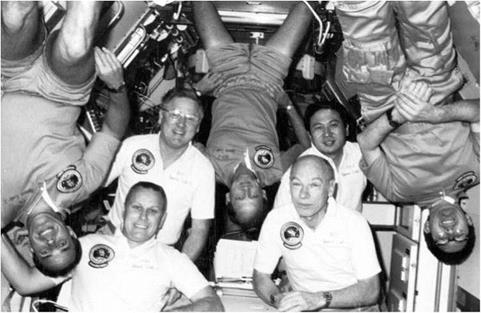STS 51-B
|
Int. Designation |
1985-034A |
|
Launched |
29 April 1985 |
|
Launch Site |
Pad 39A, Kennedy Space Center, Florida |
|
Landed |
6 May 1985 |
|
Landing Site |
Runway 17, Edwards Air Force Base, California |
|
Launch Vehicle |
OV-099 Challenger/ET-17/SRB BI-016/SSME #1 2023; |
|
#2 2020; #3 2021 |
|
|
Duration |
7 days 0 hrs 8 min 46 sec |
|
Callsign |
Challenger |
|
Objective |
Spacelab 3 research programme |
Flight Crew
OVERMYER, Robert Franklyn, 48, USMC, commander, 2nd mission Previous mission: STS-5 (1982)
GREGORY, Frederick Drew, 44, USAF, pilot LIND, Don Leslie, 54, civilian, mission specialist 1 THAGARD, Norman Earl, 41, civilian, mission specialist 2 THORNTON, William Edgar, 56, civilian, mission specialist 3 WANG, Taylor G., 44, civilian, payload specialist 1 VAN DEN BERG, Lodewijk, 53, civilian, payload specialist 2
Flight Log
Space Shuttle activities were building up to a frenetic pace by April 1985. Discovery was dispatched on mission 51-D, Challenger rolled out to the now vacant Pad 39A for 51-B, and the new orbiter Atlantis arrived at the KSC in preparation for its first mission later that year. It was all looking rather routine stuff, especially when 51-B finally got off the ground – 17 days after 51-D – with a seven-man crew that included three people over 50, as if to emphasise the apparent routine nature of manned space flight. NASA was pushing the system and time was running out. Spacelab 2 featured the Instrument Pointing System and a pallet-only development flight. It was delayed so much due to preparing the IPS that Spacelab 3 flew before it, adding to the confusing Shuttle identification sequence. Research on Spacelab 3, considered to be the first operational mission of the long series, focused on five disciplines: materials science, life sciences, fluid mechanics, atmospheric physics and astronomy. The flight featured 15 primary experiments, of which 14 were considered successful. The crew worked in two shifts: Gold (Gregory, Thagard, Van Den Berg) and Silver (Overmyer, Lind, Thornton, Wang).
Challenger lifted off just 2 minutes 18 seconds later than anticipated, after a liquid oxygen drain back had to be manually commanded, at 12: 02hrs local time.
|
(L to r) The STS 51-B crew of Gregory, Overmyer, Lind, Thagard, Thornton, Wang, and van den Berg. Note the different coloured shirts, denoting the two-shift operations |
Apart from an overheating APU which had to be shut down, the launch was smooth and Challenger, in its 57° orbit which would reach a maximum altitude of 308 km (191 miles), was placed into a tail down, nose up gravity gradient attitude, vital for the array of mainly microgravity processing experiments to be operated inside the Space – lab 3 laboratory. The two payload specialists. Lodewijk van den Berg and Taylor Wang, both naturalised American citizens, operated their own crystal growth and fluid physics experiments, the latter only after spending days getting it to work following an electrical fault that almost spoiled years of hard work.
Also on board Challenger – another Shuttle first – were two monkeys and 24 rats, to help with the study of space adaptation syndrome, SAS, under the guidance of doctors Norman Thagard and William Thornton. The performance of the Animal Holding Facility left much to be desired and the astronauts spent a lot of time clearing up floating droppings. Two small research satellites were to be deployed from GAS canisters in the payload bay, but one failed to get away. Science astronaut Don Lind, having waited a record 19 years to get into space, marvelled at the sight of the aurora borealis from space.
The highly esoteric science mission, which went over most people’s heads, was extremely successful and ended with a long rollout on the Edwards Air Force Base desert runway 17, and with the heaviest cargo to return from space – 14,198 kg (31,307 lb) – at T + 7 days 0 hours 8 minutes 46 seconds. Further landings at the KSC had been banned after the 51-D landing incident.
Milestones
105th manned space flight 48th US manned space flight 17th Shuttle flight 7th flight of Challenger
Thornton retains oldest person in space record (56) 2nd Spacelab Long Module mission











